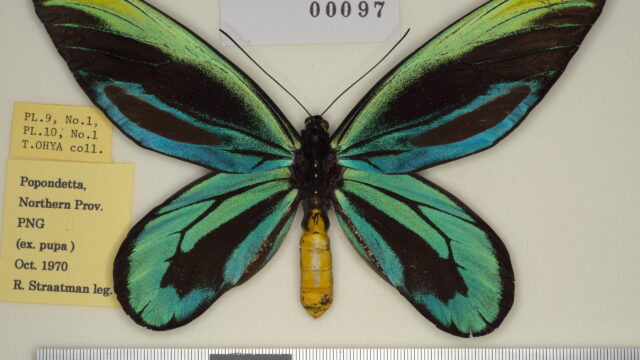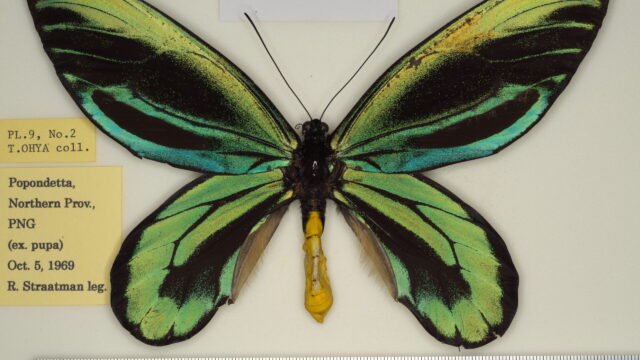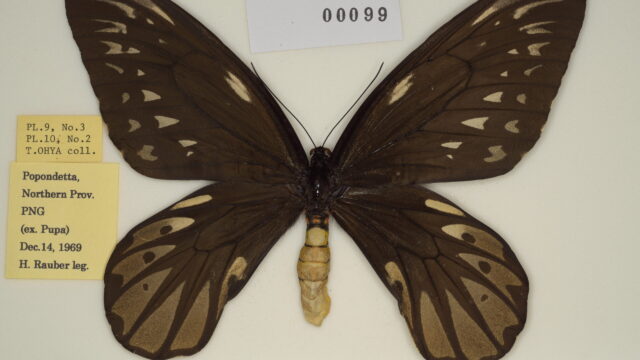Sp. alexandrae (Rothschild, 1907) 6) [♀] [♂: (Jordan, 1908)4)]
It is unique in that it is a single genus with no subspecies and no other species like this one.
(Distribution) [DCD 4], [Map 8]
PNG [NP] Taututu, Hurata, Kumusi River basin, upper Mambare River (Biagi), Sanananda, Popondetta area, Sila, Afore area, Tufi, Wanigela.
(Episodes of discovery and original description)
Meek, a well-known collector who visited the New Guinea area to collect specimens for the Tring Museum and discovered many new species of butterfly, shot down the first ♀ with a shotgun at Biagi, 5000 ft above sea level, up the Mambare River, in January 1906. He wrote: “The butterfly is so similar that it reminds me of O. victoriae.” He sent the specimen to Rothschild with a letter stating that he had also seen the ♂ but could not collect it as it was flying high in the sky. Meanwhile, he wrote to Jordan: “I think this butterfly should be named in honour of Rothschild, who assisted me on this collecting trip, after him.” Eventually, Rothschild (1907) published his opinion that the butterfly should be named alexandrae in honour of Queen Alexandra, Queen of the then King Edward VII of the United Kingdom, on the grounds that it was similar to O. victoriae butterfly. In his description, Rothschild stated that he hoped Mr Meek would visit the area again and obtain many specimens of both sexes, and Meek did not disappoint him, collecting the long-awaited ♂ in 1907. It was described by Jordan in Seitz’s “Macrolepidoptera of the World”.
The original texts of Rothschild and Meek are as follows:
(Rothschild:Novit. zool. XIV:96, 1907)“Mr. Meek intends going again to the country where he found this female and we hope that he will succeed in obtaining a good series of both sexes. The male was seen by him high in the air, but he could not get it. It had long wings like female. On account of the relationship of this new species with Troides victoriae think the name alexandrae to be very appreciate.”
(Meek, Cannibal. :173、1913) “In sending it home, I wrote to Dr. Jordan of the Tring Museum, suggesting to him that since this was the was the most important new discovery I had yet made among lepidoptera, it should be named after the Hon. Walter Rothschild, but Mr. Rothschild would not agree to, and it was named Troides alexandrae on account of its similarity to the Troides victoriae.”
(Vertical distribution)
0 – 1, 500 m. a. s. l.
(Characteristics)
It is now strictly protected internationally by CITES (Convention on International Trade in Endangered Species of World Fauna and Flora) (Appendix I), because it inhabits only a very limited area centered on Popondetta area on north coast of Southeastern PNG and is endangered.
The characteristics of O. (S.) alexandrae are as follows:
- This species is the largest butterfly in the world.
- The wing shape of ♂ resembles that of subgenus Aetheoptera, both FW and HW are elongated ovals, but the anal notch is mild.
- The cell of FW of this subgenus is not as spatulate as that of subgenus Aetheoptera, but it is more spatulate than subgenera Ornithoptera and Schoenbergia. The V2nd – V4th of subgenus Aetheoptera come close each other, but in this subgenus the V2nd – V5th approach each other.
- This subgenus have the reddish hairs on the lateral thoraxes and the white fringes at the rear edges of eyes, which lack in subgenus Aetheoptera.
(Spotted pattern)
♂: This species can be easily distinguished from other species by its huge size, unique coloration, and pattern. The FW have the broad, iridescent bluish green radial band, the iridescent blue cubital and anal bands surrounding a blackish-brown sex-brand. The HW is iridescent bluish green with black margin and black veins, and especially the black area along the cubital vein is broad.
♀: Extremely large. Blackish brown ground color with grayish brown spots. FW spots are small, and many individuals lack the cell spot. The discal spots are long and almost reach the discal cell but are narrow. The round dark discal spots are also small.
(Variation)
♂-f. atavis Rumbucher, 19737): [Aberrant HW pattern] One or more semi-translucent golden spots are present on submarginal region on HW.
♂-f. diva Schäffler, 20018): [FW/HW discoloration] Dark olive-green instead of typical iridescent bluish green.
♂-f. kampsi Deslisle & Sclavo, 20153): [FW/HW discoloration] The radial band on FW is blue instead of green.
(Larval foodplant)
Pararistolochia alexandriana, P. meridionaliana 5).


